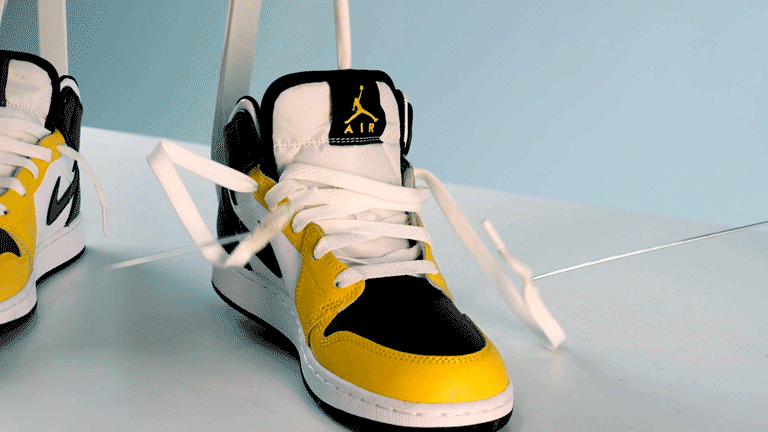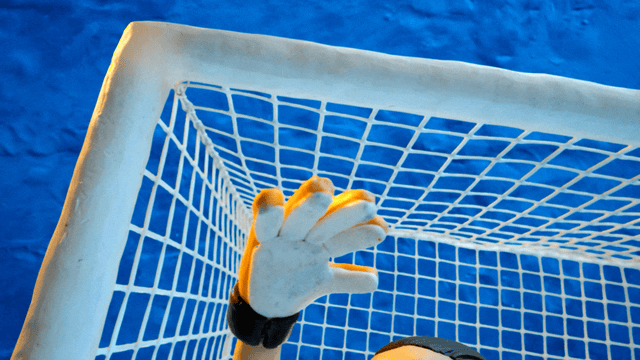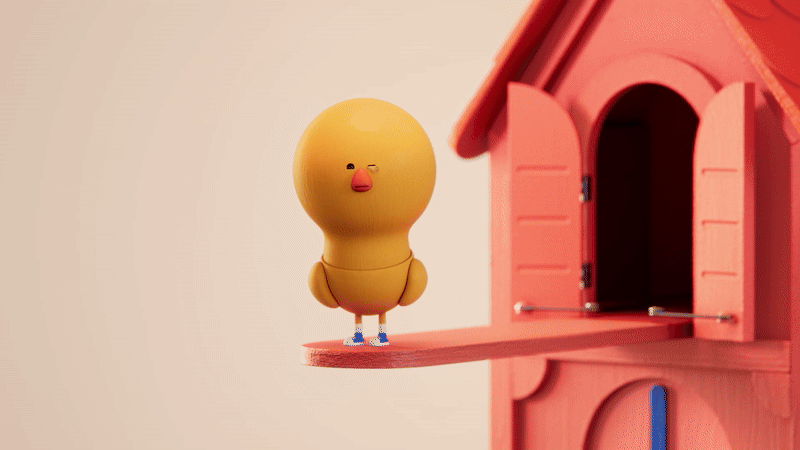How Jonny & Will gave Jordans souls
The BLINKINK puppet masters bring their reanimation skills to Jordan Brand and Nike Greater China. We caught up with the pair to find out what was needed to breathe air into icons.
The act of bringing a traditional puppet to life is some sort of alchemy; the previously prone bag of felt somehow developing humanistic idiosyncracies within seconds. But how the hell do you do it with a shoe?!
Tasked with anthropomorphising Nike Jordans without altering their iconic appearance, BLINKINK duo Jonny & Will embarked on some delightful acts of puppetry to bring action to the laces, tongues, and eyelets, in a campaign for Jordan Brand and Nike Greater China for agency Studio NOWHERE.
Made in collaboration with The Loft Films, Shanghai, the two films, Barbershop and Handshake, show an intricately designed mini-world, utilising the pair's trademark rod puppetry, stop-motion and innovative Unreal-built virtual sets to create an absorbing and endearing diorama.
We caught up with Jonny & Will to find out what it takes to kick life into kicks.
Credits
View on- Agency StudioNOWHERE
- Production Company BLINKINK
- Director Jonny & Will
-
-
Unlock full credits and more with a shots membership
Credits
View on- Agency StudioNOWHERE
- Production Company BLINKINK
- Director Jonny & Will
- Production Co. (China) The Loft Films
- Editorial tenthree
- Color The Mill/Shanghai
- VFX Furry Tail Dragon
- Sound Design Major Tom
- Sound Design Fantasy Music
- Music Major Tom
- Executive Producer Bernice Wong
- Creative Director Ryan Hu
- Creative Director Angie Fang
- Art Director Yan Wu
- Executive Producer Bart Yates
- Executive Producer Josef Byrne
- Head of Production Alex Halley
- Producer Igor Degtiarev
- Executive Producer Geok Lem
- Producer Arnold Liu
- DP Matthew Day
- Editor Nick Armstrong
- Colorist Nikola Stefanovic
- VFX Supervisor/Post Production Lead Andy Antoniou
Explore full credits, grab hi-res stills and more on shots Vault

Credits
powered by- Agency StudioNOWHERE
- Production Company BLINKINK
- Director Jonny & Will
- Production Co. (China) The Loft Films
- Editorial tenthree
- Color The Mill/Shanghai
- VFX Furry Tail Dragon
- Sound Design Major Tom
- Sound Design Fantasy Music
- Music Major Tom
- Executive Producer Bernice Wong
- Creative Director Ryan Hu
- Creative Director Angie Fang
- Art Director Yan Wu
- Executive Producer Bart Yates
- Executive Producer Josef Byrne
- Head of Production Alex Halley
- Producer Igor Degtiarev
- Executive Producer Geok Lem
- Producer Arnold Liu
- DP Matthew Day
- Editor Nick Armstrong
- Colorist Nikola Stefanovic
- VFX Supervisor/Post Production Lead Andy Antoniou
How did you guys get involved in the project?
We loved the scripts we were sent by Studio NOWHERE, the Chinese agency. They were funny and cool, and we were immediately excited to get into the project. The brief was to create a world inhabited by Nike trainers, full of details that Sneakerheads will pick up on and enjoy.
In terms of the characterisation of the sneakers and the look and feel of the environments, Nike was very involved. Luckily, we were all very much on the same page, and the development process was fun and rewarding. We gained lots of insights into how the brand likes to present themselves through the details that were requested.
What were the initial dos and don'ts?
It felt clear to us that there should be no humans in this world, so the idea of people wearing the shoe characters was something we pushed back on early in the development process.
The brief was to create a world inhabited by Nike trainers, full of details that Sneakerheads will pick up on and enjoy.
The idea of creating a place designed and built by the trainers themselves felt interesting: long bespoke barbers chairs, skateboards instead of cars, architecture based on shoe boxes, and lots of subtle cues that gave these ‘real’ environments a more stylised original feel.
Was there ever a conversation about manipulating the trainers to make them more traditional puppets?
When realising these characters, there were various routes we could have taken, possibly rebuilding the trainers as animated models or creating CGI versions. It made sense to us for this project to use actual trainers and create expressive characters by manipulating the shoes in ways they naturally flex and move.
That said, we didn’t want to make silly, wacky trainer guys with stuck-on eyes or flappy mouths; we wanted to keep the characterisation more subtle.
What were the first things to nail?
First, we had to show that we could bring these Air Jordans to life, and have the characters do what they needed to do: namely do a cool high-five handshake routine and get a spa-type cleaning treatment in a barber’s chair.
We didn’t want to make silly, wacky trainer guys with stuck-on eyes or flappy mouths.
We straight away got hold of some Jordans, attached various rods and wires, and filmed some rough puppeteered movement tests.
How did you bring life to something that can't really express emotion?
Being that the thing to be brought to life was the client’s product: Air Jordans, we already knew we weren’t going to give them eyes or legs or anything, so we were just working with the shoe itself. It’s always good to start with the object in question and see what movement or manipulation it allows without being forced or added to.
With these trainers, the fact that they needed to generally be seen flat on the ground meant the shoe’s tongue naturally read like a face; able to move and turn, giving the shoe an eyeline, which is key when creating a believable character. Also, the shoelaces on each side obviously became arms, which, through puppetry as well as stop-frame, were able to gesticulate and be very expressive.

Above: The homemade 'crap-a-matic' puppetary tests.
The project clearly required a lot of pre-production testing. What were the early issues that arose and how did you solve them?
We quickly developed the initial storyboards into rough puppeteered versions of the final films. These ‘Crap-a-matics’ became invaluable in working out camera angles, what backgrounds we will see, where puppeteers and rigs are positioned, and lighting set-ups.
It’s incredible how quickly realistic backgrounds can be created from [Unreal's] initial conception.
They became a handy guide on set to share what each set-up requires with the crew.
How was the shoot itself? Any unexpected problems?
The shoot was great; a lot to get done in two days, but we worked with loads of our favourite crew, and had fun doing it. We were puppeteering the shoes in a green-screen space, but on practical sections of set: a patch of pavement and three beautifully model-made barber’s chairs. Then the rest of the backgrounds were created in Unreal Engine to blend in with the filmed parts.
I can’t remember any major problems, but the whole project was a bit of a whirlwind!
The project clearly requires a bit of VFX to comp in sections and map out armature. What's the line you draw as to what can be 'fixed in post'?
In terms of puppetry, we always try to keep the rods from ever going in front of the puppet, so we operate from the opposite side to the camera, and sometimes use thin fishing wire rigs when one of the shoelaces has to move in front of the shoe. When filming the puppets, we try to be as helpful as we can to the post-production team, although I’m sure we have them pulling their hair out at some points!
Once we’re in the edit, we can find all the magic moments when something clicks, and a real live character emerges.
It was great fun working out the CG backgrounds with our production designer and then the post team using Unreal Engine. It’s incredible how quickly realistic backgrounds can be created from their initial conception.
We've obviously seen VFX replace what, back in the day, would have been done by puppetry in a number of cases. What do you think it is about the art of physical effects that allows it to prevail?
I think with a job like this it’s nice to see the hero product itself come to life, and there’s a subtlety and charm that comes from seeing a real object manipulated and given expression and relatable mannerisms. Puppeteering the characters on set, we get a range of different takes and performances and are able to try out different versions of things.
Once we’re in the edit, we can find all the magic moments when something clicks, and a real live character emerges.
Those elements of variety and spontaneity, I think, give practical effects a tangibility which can be very engaging on screen.
)












